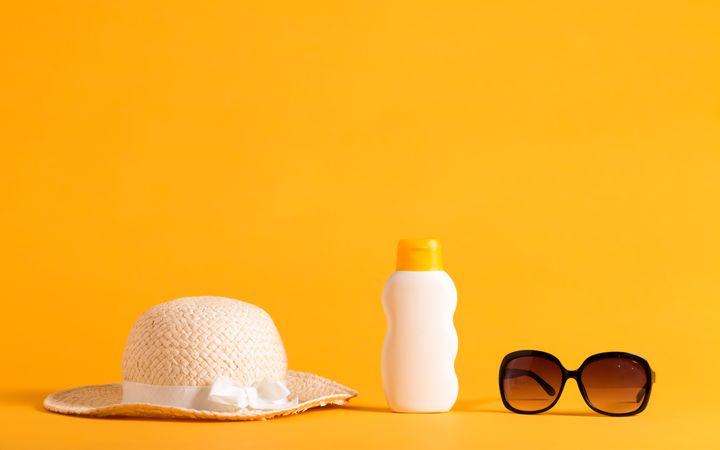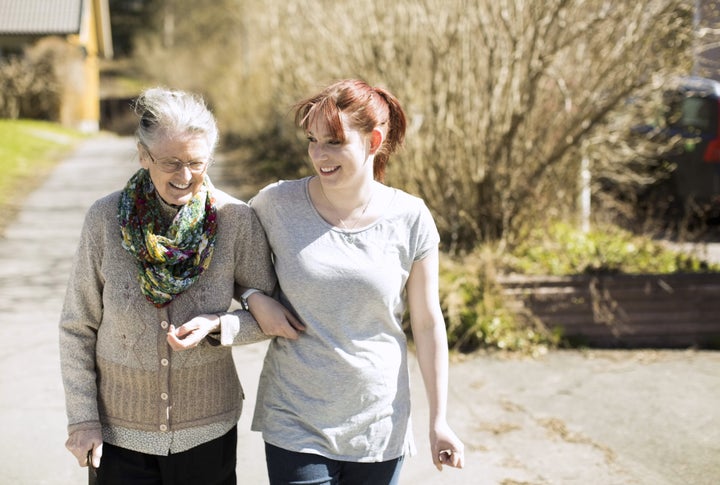
Just because summer is fading doesn’t mean you should toss your sun care routine away along with those worn out flip-flops. It’s important to take precautions against the sun 365 days a year ― no matter how old you are.
Throughout your daily endeavors, you are constantly exposed to harmful UV rays. Even on cloudy days, up to 80 percent of the sun’s rays can penetrate your skin. And, according to the World Health Organization’s Global Solar UV Index report, haze in the atmosphere can increase UV radiation exposure.
All of this can wreak havoc on your skin, causing unwanted wrinkles, breaking down collagen and, most alarmingly, increasing the chances of developing skin cancer. According to the American Academy of Dermatology, 1 in 5 Americans will be diagnosed with skin cancer at some point in their lifetime.
Fortunately, you can take measures to help prevent excessive sun damage. And the practices will pay off as you grow older: An estimated 90 percent of skin cancers are caused by the sun’s damaging rays, so taking precautions now can help you for years to come.
Here’s what you should do as a daily sun care routine ― whether you’re in your summer shorts or your winter wool ― throughout each decade of your life:
20s

You’re not invincible when you’re young. Taking care of your skin is perhaps the most crucial when you’re in your 20s, according to experts.
A lot of people at that age “don’t think they are at risk of skin cancer, but the sun exposure we get in childhood adds to our risk of developing skin cancer later in life,” said Holly Gunn, a dermatologist at the University of Alabama at Birmingham.
Since this decade is the time to really step up your defense against ultraviolet rays, here are some habits you should definitely practice on a regular basis in order to stay healthy.
Avoid tanning beds.
People still frequent tanning beds, “despite the clear data that they have been found to increase the risk for melanoma by 75 percent,” said Elizabeth Hale, a board-certified dermatologist and clinical associate professor of dermatology at the New York University Langone Medical Center.
Women who have ever tanned indoors are six times more likely to be diagnosed with melanoma in their 20s than those who have never tanned indoors, according to the Skin Cancer Foundation. Hale suggested trading in tanning beds and overexposure to the sun for sunless self-tanners.
Make sunscreen a regular part of your routine.
You may lather up for a day at the beach, but it’s best to always be protected.
“People often overlook the sneaky sun exposure that is a constant lurking risk ― driving in the car, sitting by your office or home window, walking to or from work ― even just in between buildings repeatedly, five minutes here or there,” said Annemarie Fogerty, a hematologist and oncologist at Massachusetts General Hospital.
Fogerty recommended “liberal and repetitive application of sunscreen” of an SPF 30 or above, no matter the season.
Become chummy with a dermatologist.
Early detection is key. Fogerty suggested that people get dermatology screening for skin cancers ― typically every one to two years, depending on your skin tone and appointment findings ― starting in your 20s. This is also a great way for you to keep a running dialogue going with your dermatologist on what you can be doing as the years go by to further protect yourself from the sun.
Start regularly wearing sunglasses.
Doing so can help to ward off visual ailments such as photokeratitis, a condition that can cause sunburn of the eye that in turn can cause loss of vision for up to 48 hours, cataracts and age-related macular degeneration, said Jennifer Burke, owner of Eyediology Vision Care, a private practice in Las Vegas.
“Look for glasses that provide both UVA and UVB protection and opt for wraparound or close-fitting sunglasses with wide lenses that protect your eyes from every angle,” she said.
30s

The 30s are a time you may “start to notice the undesirable effects of sun exposure starting to show up on the skin,” Hale said.
Being proactive in this decade can really help minimize additional damage, so experts recommend engaging in certain protective behaviors for your skin.
Protect the delicate skin around your eyes.
One of the earliest signs of sun exposure that pops up for women in their 30s is the appearance of crow’s feet. To combat these unwanted lines around the eyes, Hale recommended wearing sunglasses every day, in addition to a broad-spectrum sunscreen like Coppertone Clear Zinc SPF 50.
Avoid being outdoors when the sun is the strongest.
Robin Evans, a board-certified dermatologist at Southern Connecticut Dermatology, suggested “choosing your activities wisely and using caution so as to avoid sun exposure during the most intense times of the day,” typically between 10 a.m. and 4 p.m. So walk your dog before heading off to work in the morning or accompany your child for a bike ride in the early evening hours.
Protect your collagen.
Another good reason to keep up with the daily SPF: It helps prevent the breakdown of collagen.
“Collagen gives skin its youthful thickness, firmness, strength and even texture, but loss of collagen leads to thinned skin, permanent wrinkles, easy skin tearing, poor wound healing,” said Tsippora Shainhouse, a dermatologist and clinical instructor at the University of Southern California. She added that collagen breakdown occurs naturally with aging and noted that UV rays actually accelerate the collagen breakdown process, “making your skin look older sooner.”
40s

The majority of premature skin aging signs can be attributed to sun exposure, according to Hale. If you slacked on sun care in your 20s and 30s, experts stress that this decade is really important to establish healthy habits.
Prevent sun spots.
Continued sun exposure can cause sunspots to begin to appear, which become much more common in your 40s, Hale said.
“These are best prevented with sun protective behaviors, such as wearing regular sunscreen,” she said. So continue to make your SPF application a daily thing.
Beef up your skincare routine.
According to Diane Elizabeth, the founder of Skin Care Ox, your 40s are the time to start using skin care products that can reverse existing sun damage.
Elizabeth recommended adding a potent vitamin C serum to your regimen, which has been shown to “increase collagen production, help reverse sun damage and can also provide a little UV protection,” she said.
Products that contain resveratrol can also “fight free radicals and slow or prevent DNA damage from the sun’s rays,” Elizabeth said. Including antioxidants and fatty acid omegas in your diet could also help to protect your skin from the inside out, she said.
Don’t let the sun exacerbate hormonal skin changes.
“Hormones [from] pregnancies, hormonal birth control and menopause can trigger melasma and skin dyspigmentation on the face. UV exposure can darken these patches,” Shainhouse said.
In addition to keeping up with your sun defense routine, Shainhouse recommended adding a facial topical product that helps to break down pigments and/or prevent pigment formation. “Look for ingredients like hydroquinone, kojic acid, vitamin C or azaleic acid,” she said.
50s

“At this age, you most likely have some sun damage,” said Debra Jaliman, an assistant clinical professor of Dermatology at the Icahn School of Medicine at Mount Sinai in New York and author of Skin Rules: Trade Secrets from a Top New York Dermatologist.
Her best advice for safe sun exposure in this decade is to diminish the damaging effect of the sun’s rays by wearing wide brim hats and protecting the skin with clothing, preferably attire outfitted with UPF (ultraviolet protection factor).
Watch out for products that make your skin sun sensitive.
“Many people at this age use retinoids to help with fine lines and wrinkles,” Jaliman said. But products that contain retinoids can make your face more sun sensitive. For this reason, Jaliman recommended always using sunscreen with retinol.
Keep up your healthy habits.
This includes sun care, skin care and diet, said Alline Arguelles, a full specialist esthetician and spa manager at Conrad Spa at the Conrad Fort Lauderdale Beach resort in Florida.
To give your skin some TLC after decades of sun exposure, Arguelles recommended using facial products that contain “hyaluronic acid to keep skin hydrated and peptides, which are the building blocks of collagen and elastin” ― the two proteins responsible for warding off wrinkles and fine lines. Elastin, in particular, helps the skin to return to its original position after being stretched.
Try DNA repair enzymes.
“Most of my patients in their 50s and up are trying to reverse the effects of the sun damage they experienced in their youth, which is why it’s so important to start early with sun protection,” Hale said. She recommended asking your dermatologist about products that contain DNA repair enzymes that may help mitigate some of the damage incurred by the sun.
60s and 70s

All hope of protecting your skin as you age isn’t lost the more birthdays you celebrate.
“While many signs of sun damage have already appeared by this age, it is never too late to start protecting one’s skin every day,” Hale said. Healthy lifestyle habits are key here.
Keep up with the sunscreen.
Studies show that daily sunscreen use can help reverse some signs of sun damage. It can also help to prevent the occurrence of skin cancers. Sun-induced pre-cancer can also occur, and are actually extremely common in this age group, Hale said. And, as a person ages, they become more sun sensitive.
“So someone in this age bracket will experience sunburn quicker than at previous times in their life,” Jaliman said.
Be careful with medications.
Those in this age bracket “are more likely to be on medications that may increase their sensitivity to sun exposure,” Jaliman said. Drugs that may cause photosensitivity include certain antibiotics, over-the-counter antihistamines like Benadryl, non-steroidal anti-inflammatory drugs like ibuprofen, and herbal supplements. Make sure to read the labels.
80s and beyond

As you age, signs of sun damage and the occurrence of skin cancer increase. But experts noted that it’s never too late to reap the benefits of daily sun defense, so keep up with your sunscreen applications and continue to wear hats, sunglasses and clothing as part of your sun-care routine.
Stay hydrated.
“Too much outdoor time and being exposed to the sun excessively can lead to problems like sunburn and dehydration in the elderly,” Jaliman said.
She recommended increasing your intake of water during days that featre a lot of sun time.
Hale added that this demographic should seek shelter under an umbrella or in the shade whenever outdoors for an extended period of time.
Freshen up your products.
Don’t just reach for that old bottle of sunscreen that’s been sitting in your cabinet for some time. Joseph Cruise, a board-certified plastic surgeon in Newport Beach, California, recommended checking your sunscreen expiration date before using it, “as the active ingredients sunscreen can lose their potency.”
If your SPF-filled lotion is old, it’s time to replace it.